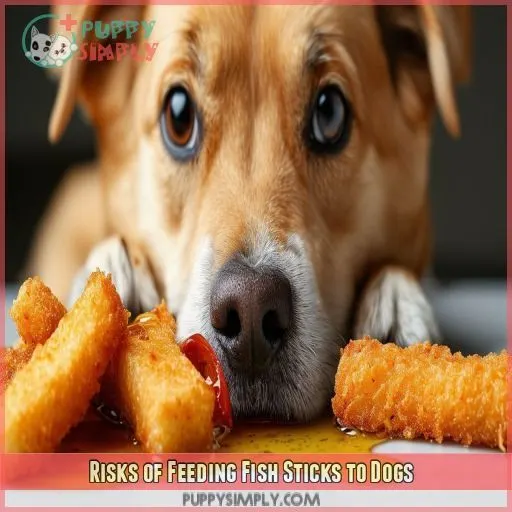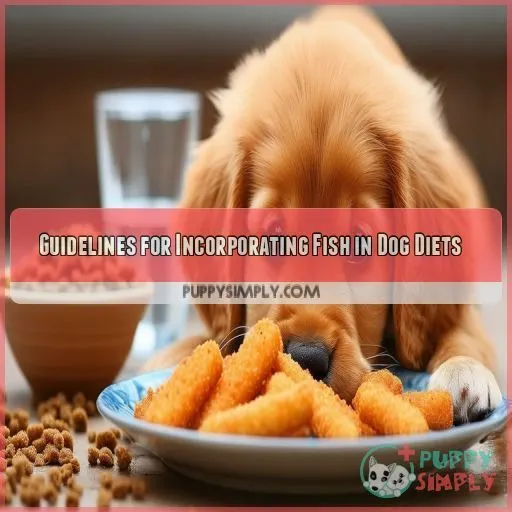This site is supported by our readers. We may earn a commission, at no cost to you, if you purchase through links.
 Fish sticks can be a tricky treat for your dog.
Fish sticks can be a tricky treat for your dog.
While they provide a lean protein source, they’re often loaded with sodium and unhealthy oils.
These additives can upset your dog’s stomach and cause digestive issues.
There are safer fishy options to treat your pup.
Stay tuned to learn healthier alternatives to fish sticks and how to safely incorporate fish into your dog’s diet.
Table Of Contents
Key Takeaways
- Fish sticks are a no-go for your furry friend due to high sodium levels and unhealthy oils, which can cause digestive issues and even salt poisoning.
- Fish is a superfood for dogs, packed with protein, omega-3 fatty acids, vitamins, and minerals, but it’s important to choose low-mercury options like salmon or sardines and prepare it safely.
- Fresh fish, homemade fish treats, and commercial fish-based dog foods are healthier alternatives that provide the benefits of fish without the risks.
- Always consult your veterinarian for personalized advice on incorporating fish into your dog’s diet, including the right types, preparation methods, and serving sizes.
Fish Sticks and Dogs: an Overview
So, can your furry friend join you for fish sticks and chips? Before you share your snack, let’s take a closer look at fish sticks and dogs. We’ll talk about what fish sticks are made of, how they might affect your dog’s health, and any potential risks to watch out for.
Composition of Fish Sticks
Fish sticks: a crispy, golden treat for us, but are they suitable for our furry friends? Let’s break it down.
When it comes to fish sticks, we need to think about the breading type and sodium levels. The breading, usually a combo of flour and breadcrumbs, gives ’em that signature crunch. But, it’s the added sodium and oils that we need to watch out for.
Nutritional Value for Dogs
Fish sticks, while not the ideal food for your canine companion, do offer some nutritional benefits. Here’s a quick overview of the nutritional value of fish for dogs:
- Protein: Fish is a great source of protein, which is essential for your dog’s muscle development, tissue repair, and immune function.
- Omega-3 Fatty Acids: These support joint health, brain function, and a healthy skin and coat.
- Vitamins and Minerals: Fish provides essential vitamins and minerals, including Vitamin D, B-complex vitamins, Selenium, Iodine, and Zinc.
- Digestibility: Cooked fish is easily digestible for dogs.
- Allergy Alternative: Fish can be a good option for dogs with allergies to common proteins like chicken.
Potential Risks and Concerns
Fish sticks come with a few risks and concerns for your furry friend. While an occasional fish stick mightn’t cause immediate harm, it’s important to think about the ingredients and potential health hazards.
The breading and oils used in fish sticks can upset your dog’s stomach, leading to digestive issues like pancreatitis or even obesity. Not to mention, fish sticks are often loaded with preservatives, flavor enhancers, salt, and sugar—ingredients that offer little nutritional value and may cause tummy troubles.
Excessive sodium levels in fish sticks can be dangerous, potentially leading to salt poisoning with symptoms like vomiting, diarrhea, tremors, or seizures.
It’s also important to think about the potential for choking hazards. Fish sticks may contain small bones that can get lodged in your dog’s mouth, throat, or intestines, causing serious injuries.
Nutritional Benefits of Fish for Dogs
Fish isn’t just tasty for your pup, it’s also packed with health benefits. From promoting healthy skin and a shiny coat to supporting brain function, fish is a superfood for dogs.
High-Quality Protein Source
Fish is a fantastic source of high-quality protein, which is essential for your dog’s muscle growth and repair. Here are some key benefits of fish as a protein source for your furry friend:
- Muscle Development: Protein is important for building strong muscles, especially for active dogs.
- Tissue Repair: It helps in repairing damaged tissues, keeping your dog’s body healthy and strong.
- Immune Function: Protein plays a key role in supporting your dog’s immune system, helping them stay healthy and fight off illnesses.
- Energy Levels: High-quality protein sources like fish can contribute to maintaining your dog’s energy levels throughout the day.
Omega-3 Fatty Acids
Fish are chock-full of omega-3 fatty acids, which are like superfoods for your dog’s skin and coat. They’re nature’s anti-inflammatories, reducing redness and itchiness. Think of them as a spa treatment for your pup’s skin, leaving their coat soft and shiny. Omega-3s also support joint health and brain function, so your furry friend stays active and sharp.
Essential Vitamins and Minerals
Fish is a great source of essential vitamins and minerals for your dog.
It’s like a tasty multivitamin, packed with Vitamin D, B-complex vitamins, Selenium, Iodine, and Zinc.
These nutrients are key players in keeping your pup’s bones strong, their energy levels up, and their overall health on point.
Risks of Feeding Fish Sticks to Dogs
While fish can be a nutritious treat for your furry friend, fish sticks come with some risks. You might be wondering if it’s safe to share your fish sticks with your dog, and if so, how often and how much is too much?
Let’s take a closer look at the potential dangers of feeding fish sticks to dogs and explore healthier alternatives to make sure your pup gets the best nutrition without compromising their health.
Additives and Preservatives
Fish sticks may contain preservatives, flavor enhancers, salt, sugar, and unhealthy oils. These additives offer little nutritional value and can cause digestive issues in dogs. It’s important to read labels carefully and opt for plain, unprocessed fish instead. Here are some key concerns regarding additives and preservatives in fish sticks:
- Preservatives and Flavor Enhancers: These can include artificial chemicals and additives that may be harmful to dogs in the long run. Natural preservatives like rosemary extract or vitamin C are safer alternatives, but it’s best to avoid heavily processed fish products altogether.
- Salt and Sugar: Excessive salt intake can lead to salt poisoning in dogs, resulting in vomiting, diarrhea, tremors, or even seizures. Sugar, on the other hand, provides empty calories and can contribute to weight gain and health issues like diabetes.
- Unhealthy Oils: Fish sticks are often fried in unhealthy oils, such as palm oil or hydrogenated oils, which are high in saturated fat and can negatively impact your dog’s heart health.
- Digestive Issues: The combination of additives, preservatives, and unhealthy oils in fish sticks can upset your dog’s stomach and lead to digestive problems like pancreatitis or obesity.
High Sodium Content
While fish is a great source of protein and omega-3 fatty acids for your dog, fish sticks are a different story. They’re often loaded with sodium, which can be dangerous for dogs. Too much sodium can lead to salt poisoning, causing vomiting, diarrhea, tremors, or even seizures.
| Signs of Salt Poisoning in Dogs |
|---|
| Vomiting |
| Diarrhea |
| Tremors |
| Seizures |
| Excessive Thirst |
Breading and Unhealthy Oils
Breading and oils in fish sticks can upset your dog’s stomach, leading to vomiting and diarrhea. These issues may stem from the breading, which can be hard for dogs to digest. Unhealthy oils, especially when heated, can also trigger digestive problems like pancreatitis or contribute to obesity.
Potential for Choking Hazards
Feeding fish sticks to your dog comes with a set of risks, and choking is one of them. Here are a few reasons why fish sticks can pose a choking hazard:
- Fish Bones: Fish bones are small, brittle, and dangerous. They can easily lodge in your dog’s mouth, throat, or digestive tract, leading to serious health risks.
- Breading and Oils: The breading and oils used in fish sticks can also increase the risk of choking. These ingredients can form a sticky mass in your dog’s throat, causing an obstruction.
- Size and Shape: Fish sticks are often designed for human consumption and may be too large or irregularly shaped for dogs to chew and swallow safely.
Safe Fish Options for Canine Consumption
Choosing safe fish options for your furry friend means picking the right type and preparing it properly. You’ll want to opt for fish that are low in mercury, such as salmon, sardines, and mackerel, and make sure to cook it thoroughly before serving.
Low-Mercury Fish Species
When choosing fish for your canine companion, it’s important to opt for low-mercury varieties. Here’s a table outlining some safe choices:
| Low-Mercury Fish | Safe for Dogs? | Additional Notes |
|---|---|---|
| Salmon | Yes | A great source of Omega-3 fatty acids |
| Sardines | Yes | Choose brands packed in water with no added salt |
| Mackerel | Yes | Avoid King Mackerel due to high mercury levels |
| Whitefish | Yes | Both ocean and lake varieties are safe |
| Flounder | Yes |
Proper Preparation Methods
When preparing fish for your dog, it’s important to keep it simple and safe. Always cook the fish thoroughly, without any added oils or seasonings. Fish should be cooked to the same standards as you’d for human consumption. Avoid frying, as this adds unnecessary fats and can be harmful to your dog’s health.
Recommended Serving Sizes
Serving sizes matter, and moderation is key.
Fish should be an occasional treat, making up no more than 10% of your dog’s diet.
Aim to serve fish once or twice a week to provide a variety of nutrients without overdoing it.
Remember to adjust portion sizes based on your dog’s size and weight.
A small fish fillet or a few fish treats are generally appropriate, but always consult your veterinarian for personalized advice.
Healthier Alternatives to Fish Sticks for Dogs
So, what’re some healthier options to fish sticks that you can feed your furry friend? Let’s look at some alternatives that will provide your pup with all the benefits of fish without the risks associated with fish sticks.
Fresh fish, homemade fish treats, and commercial fish-based dog foods are all healthier alternatives to fish sticks that you can safely offer your canine companion.
Fresh Fish Options
If you’re looking for healthier alternatives to fish sticks for your dog, consider these fresh fish options:
- Salmon
- Sardines
- Mackerel
- Herring
These fish are safe for your furry friend, and they’re also packed with essential nutrients like omega-3 fatty acids, which promote a healthy coat and reduce inflammation. Just remember to always cook the fish thoroughly and avoid adding any harmful ingredients like garlic or onion.
Homemade Fish Treats
Making your own fish treats for your dog is a paws-itively great idea!
You can control the ingredients and avoid the additives and excess sodium found in fish sticks.
Opt for low-mercury fish like salmon, sardines, or mackerel.
Skip the breading and oils, and try baking or air-frying for a crunchy treat.
You can also add fruits and veggies for extra vitamins and minerals.
Just remember to cook the fish thoroughly and remove all bones to keep your furry friend safe.
Always consult your vet for personalized advice.
Commercial Fish-Based Dog Foods
Commercial fish-based dog foods offer a convenient and nutritious alternative to fish sticks. When choosing a brand, look for quality ingredients and named fish sources like "salmon" or "whitefish." Specialized formulas for senior dogs or those with health issues can provide extra support. Talk to your vet before switching to a new food, especially with specific dietary needs.
Guidelines for Incorporating Fish in Dog Diets
So, you want to share your seafood supper with your furry friend? Before you do, let’s take a look at the do’s and don’ts of incorporating fish into your dog’s diet. From choosing the right fish to knowing how much and how often to feed, we’ll cover all the bases to keep your pup healthy and happy.
Frequency of Fish Consumption
So, how often can your furry friend indulge in some fishy goodness? Well, it’s all about moderation. You don’t want to overfeed your pup, but fish can be a healthy treat or addition to their diet once or twice a week. Here are some key points to keep in mind:
- Moderation is key: Plain, cooked, steamed, or grilled fish is fine in moderation.
- Avoid overfeeding: Too much fish can lead to obesity, and no one wants a chubby pup.
- Consult your veterinarian: Vets are there to help, so ask them about appropriate serving sizes for your dog’s specific needs.
- Table scraps are unnecessary: While your dog may give you those puppy dog eyes, remember that fish scraps aren’t essential for their health.
- Treats should be limited: Treats, including fish, should only make up about 10% of your dog’s daily diet.
Balancing Fish With Other Protein Sources
While fish is a fantastic treat for your furry friend, it’s important to remember that variety is the spice of life!
| Protein Sources | Benefits |
|---|---|
| Fish | Omega-3 fatty acids, novel protein |
| Lean meats | High-quality protein, essential nutrients |
| Eggs | Amino acids, biotin, selenium |
| Dairy | Calcium, vitamin D, probiotics |
Rotate different protein sources to make sure your dog gets a well-rounded diet. Remember, moderation is key!
Consulting With a Veterinarian
While the above guidelines provide a general framework for incorporating fish into your dog’s diet, it’s always best to consult with your trusted veterinarian. They can offer personalized advice based on your dog’s unique health needs, breed, age, and size.
Veterinarians are well-versed in canine nutrition and can provide specific recommendations for including fish in your dog’s diet. They can also advise on specific types of fish, preparation methods, and serving sizes that align with your dog’s individual requirements.
Frequently Asked Questions (FAQs)
What happens if my dog eats a fish stick?
While it mightn’t cause immediate harm, a fish stick isn’t the healthiest snack for your furry friend. The breading and oils in fish sticks can upset your dog’s stomach and lead to digestive issues like pancreatitis or obesity.
What happens if my dog eats fish?
If your dog eats fish, it’ll probably be fine. Fish is a good source of protein and vitamins for dogs, but check with your vet, as some fish contain high levels of mercury.
Are fish fingers OK for dogs?
You might be tempted to toss your dog a fish finger as a tasty treat, but it’s best to avoid it. Fish fingers are usually breaded and fried, which can upset your pup’s stomach and lead to digestive issues like pancreatitis.
Is it OK to give dogs seafood sticks?
Seafood sticks aren’t toxic to dogs, but they’re not ideal either. The breading, oils, and additives can upset your dog’s stomach and cause digestive issues like pancreatitis or obesity.
Are frozen fish sticks safe for dogs?
You might be wondering if frozen fish sticks are safe for your dog to eat. Well, wonder no more—they’re not a good idea. Fish sticks are a no-go for dogs due to the breading, oils, and additives, which can cause digestive issues and pose health risks.
Can dogs eat sushi?
Dogs can eat sushi, but it’s best served in moderation as an occasional treat. Avoid soy sauce, wasabi, ginger, raw fish, avocado, and added sugar.
Can puppies eat fish?
Fish can be a great treat for your pup, offering a healthy dose of protein, vitamins, and omega-3 fatty acids. Just be sure to steer clear of fishy no-nos like garlic, onion, and butter, and opt for fish low in mercury, like salmon or sardines, instead of tuna.
Is it okay to feed my dog fish every day?
Fish is best fed to dogs in moderation, and it’s recommended to serve it only once or twice a week. Talk to your vet to make sure your dog’s getting the right nutrients and portion sizes.
Are fish sticks toxic for dogs?
You’re worried if fish sticks are toxic for your dog. While not toxic, they’re not ideal either. The breading, oils, and additives can upset your dog’s stomach and cause digestive issues.
Conclusion
While fish sticks may be tempting to share with your furry friend, it’s clear that there are safer and healthier options to satisfy their fishy cravings.
Opt for fresh fish, homemade treats, or commercial fish-based dog foods instead.
When in doubt, always talk to your veterinarian to make sure your dog gets the best nutrition possible.
Now you know the ins and outs of can a dog eat fish sticks.












